뉴스&스피킹(영자신문)
하루 10분이면 영어에 대한 두려움을 극복하고 누구나 유창하게 영어를 구사하실 수 있습니다.
-
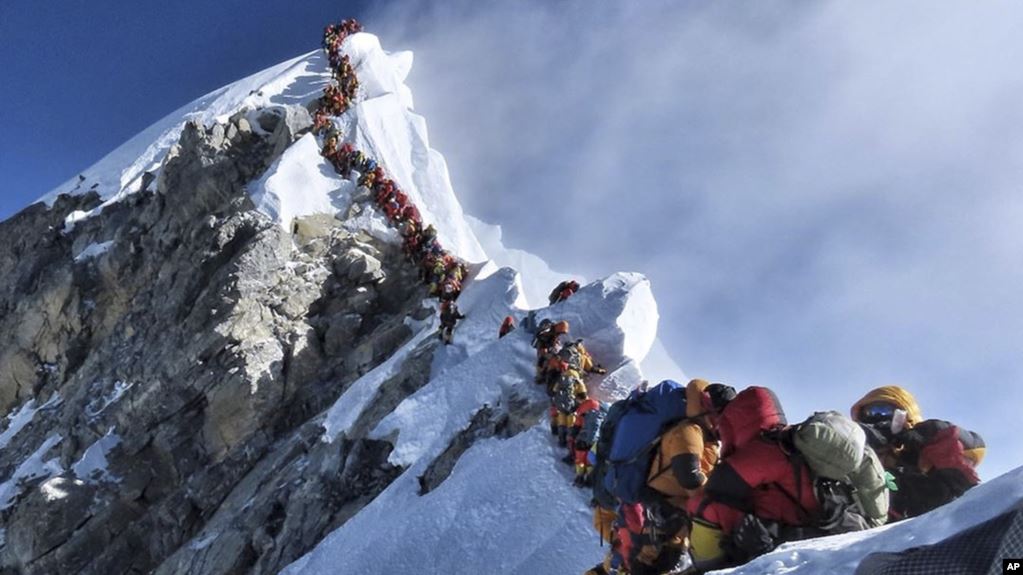 Who Should Climb Everest? A Nepalese official says that it is time to examine the rules on who is permitted to climb Mount Everest, the world’s tallest mountain.
Who Should Climb Everest? A Nepalese official says that it is time to examine the rules on who is permitted to climb Mount Everest, the world’s tallest mountain.
Yagya Raj Sunuwar told The New York Times this week, “It’s time to review all the old laws.” The parliament member’s comment comes after the deaths of at least 11 climbers this year.
Climbing Everest has been a dream for many people ever since Edmund Hillary and his guide, Tenzing Norgay, reached the top of the mountain in 1953.
Nepal is one of the world’s poorest countries. The climbing industry brings in $300 million each year. Officials do not limit the number of permits the country issues to climbers.
This year, the government of Nepal issued Everest permits to 381 people, the highest number ever. Anyone can get a permit for an $11,000 fee.
A picture taken on May 22 shows a long line of climbers wearing colorful winter clothes as they make their way up the mountain. The climbers are standing on a snow-covered ridge with a 2,000-meter drop on either side. They are hanging on to a single line of rope.
“There were more people on Everest than there should be,” said Kul Bahadur Gurung, the general secretary of the Nepal Mountaineering Association. He added, “We lack the rules…that say how many people can actually go up and when.”
At one time, only experienced mountaineers tried to climb Everest. But the cost of such an effort has decreased. This has led more and more inexperienced climbers to try to reach the top of Everest. Nepal only requires that climbers have a note from a medical doctor saying they are physically fit. Climbers do not have to prove they have the strength or ability to perform at extreme heights.
The number of climbers who have died this season is the highest since 2015. Most of those who died are believed to have suffered from altitude sickness. The condition is caused by low amounts of oxygen in extremely high places. It can lead to severe headaches, stomach sickness, shortness of breath and mental confusion. Because of the altitude, climbers have just hours to reach the top before they are at risk of having their lungs fill with liquid.
The area between Camp Four (8,000 meters) and the top of Everest (8,850 meters) is known as the “death zone.” When a climber dies in this zone, his or her body is left there. It would be too dangerous for another climber to spend their energy bringing the body down the mountain.
Eric Murphy made his third climb on Everest this year. He told the Associated Press, “Every minute counts there.” He said some tired climbers with no one to help them could take 17 hours -- instead of 12 -- to reach the top. For inexperienced climbers, that is “enough to have a profound effect.”
Among those who have died at Everest this year is American Christopher Kulish. He was from the state of Colorado. Kulish died on his way down, shortly after reaching the top. Just before he died, Kulish made it into the so-called “Seven Summit Club” of mountaineers who have reached the highest peaks on every continent, his brother said.
Mohan Krishna Sapkota is secretary of Nepal’s Ministry of Tourism and Civil Aviation. He blamed weather, equipment and lack of oxygen for this year’s deaths.
However, he added, “In the next season we will work to have double rope in the area below the summit so there is better management of the flow of climbers.”
Mirza Ali is a Pakistani mountaineer and tour operator who reached Everest’s peak for the first time this month. It was his fourth time trying. He said, “Everybody wants to stand on top of the world.” But he said visitors who are unprepared for the extremes of Everest harm the mountaineering industry.
Ali added, “The more people come, the more permits, more business. But on the other side of it is a lot of risk because it is costing lives.”
I'm Alice Bryant.View -
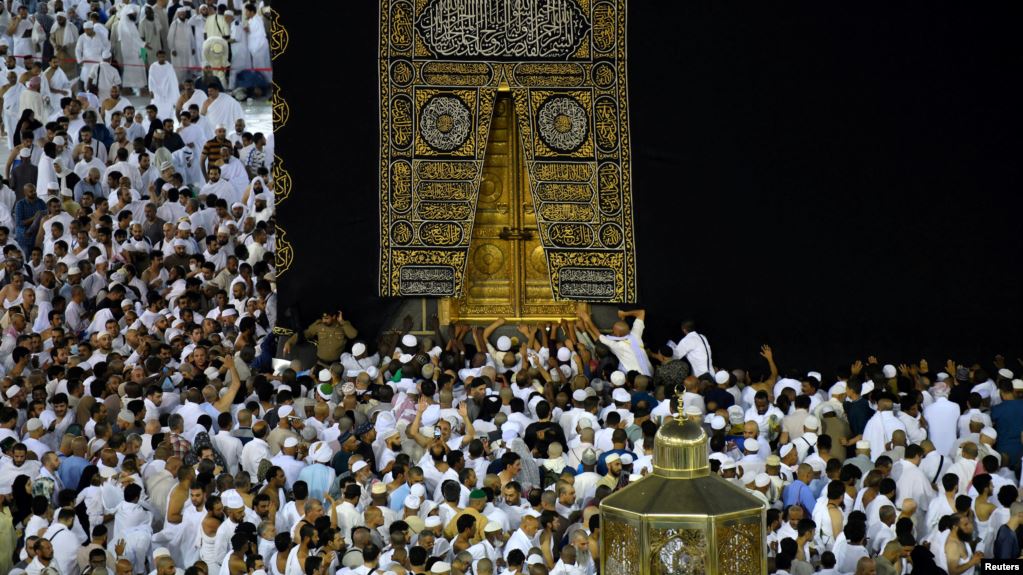 Technology, Social Media and Ramadan Technology is shaping the way Muslims spend Ramadan.
Technology, Social Media and Ramadan Technology is shaping the way Muslims spend Ramadan.
Islam requires followers to go without food, water and other liquids between sunrise and sunset during the Muslim holy month. This religious custom, known as fasting, is meant to bring people closer to God.
Now during Ramadan, more and more Muslims are spending time on social media, computers and other electronic devices.
People in the Middle East spend close to 58 million more hours on Facebook during the month. They also watch more YouTube videos now than at any other time of the year. This makes Ramadan an important time of the year for advertisers.
Ramez Shehadi is Facebook’s managing director for the Mideast and North Africa. “Consumption and time spent on our platforms does indeed increase,” he said of Ramadan.
In general, Muslims stay up a lot more at night during Ramadan and have more free time. This is especially true before “iftar,” the nightly meal that breaks the daylong fast, and the “suhoor,” when people gather to eat before another day of fasting. Many people also work shorter hours during the day.
All that means that people have more time to look at social media. Shehadi said that during Ramadan, people spent 5% more time on Facebook’s platforms. That represents nearly 58 million more hours. Put another way, there are almost 2 million hours of additional time spent daily on Facebook in the Mideast during Ramadan.
So much advertising money is spent during Ramadan that Google launched “The Lantern Award” to celebrate the most creative ads of the month.
Google does not report total watch time for YouTube during Ramadan. But the American company says that in Egypt, Saudi Arabia and the United Arab Emirates, for example, viewing of sports videos jumps by 22%. Viewing of travel videos increases by 30%, and action games, simulation and video games see an increase of 10-20% during the month.
People also spend 27% more time watching religious material on YouTube.
Joyce Baz is Google’s head of communications in the Mideast and North Africa. “To us, YouTube brings people together. We see a lot of people wanting to watch things together,” she said.
Baz added that Google products, like its search engine, are there “to simplify people’s lives so that they can focus on things that matter like being with their loved ones and family.” The company’s “Qibla Finder,” for example, helps Muslims find the direction of Mecca so they can pray toward it, wherever they happen to be.
Google says the top trending searches during the first week of Ramadan this year were surprising. In Egypt, Iraq and Saudi Arabia the top results included a mix of “Game of Thrones,” prayer times, Ramadan TV shows, movie timings and English Premier League games.
To better connect with about 180 million users in the Middle East, Facebook and Instagram launched special Ramadan icons. These signs or images give people more ways of expressing themselves online. Instagram also has a campaign to promote acts of kindness during the month.
Shehadi said that Facebook is trying to magnify “goodness as opposed to what might seem on the surface” to be more “consumerism.” He also said the idea of Facebook is about “bringing people together around things that matter to them.” This idea is close to the ethos, or spirit of Ramadan, he added.
Haitham el-Ghoneim, a Jordanian living in Dubai, said he uses Facebook to connect with friends during Ramadan. He shares traditional greetings for the holy month and communicates with his family in Jordan.
Still, he does not think the rest of it — all that time spent online, on games and ads — is a good thing. “It’s not being spent in a useful way. It’s mostly fake news, or jokes and things that have no benefit,” he said.
I'm John Russell.
And I’m Jill Robbins.View -
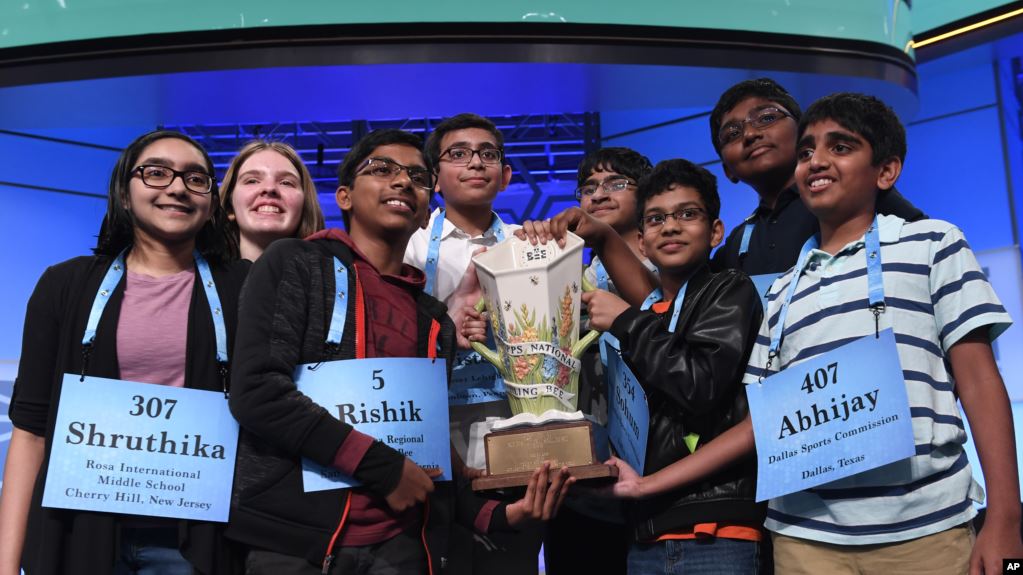 Spelling Bee Ends with Historic Eight-Way Tie Eight young “super-spellers” beat the dictionary to share victory at the 92nd Scripps National Spelling Bee.
Spelling Bee Ends with Historic Eight-Way Tie Eight young “super-spellers” beat the dictionary to share victory at the 92nd Scripps National Spelling Bee.
The final part of the historic bee began on Thursday night with sixteen spellers remaining. After almost four hours and 17 rounds of spelling, eight competitors still remained. In most years, a single competitor wins much earlier in the night.
There were so many strong spellers still remaining that bee officials began worrying that they did not have enough difficult words left to ask them.
So, at the end of round 17, longtime bee pronouncer Jacques Bailly announced, “Champion spellers, we are now in uncharted territory….We do have plenty of words remaining on our list. But we will soon run out of words that will possibly challenge you, the most phenomenal collection of super-spellers in the history of this competition.”
Bailly then explained that all spellers still standing after the 20th round would be named co-champions.
By the end of round 20, all eight still remained. The happy group created their own word for their joint success: “octochamps.”
Each will receive a $50,000 prize.The competition started on Tuesday with 562 spellers from across the nation, U.S. territories and six other countries: the Bahamas, Canada, Ghana, Jamaica, Japan and South Korea.
Officials say that while there have been co-winners in the past, there has never been as many as eight.
The crowd reacted wildly as each competitor stepped forward and successfully spelled their word in the final round.
The winners are six boys and two girls, all between the ages of 12 and 14.
Rishik Gandhasri is 13 years old and from California. His final word, Auslaut, a German-based word that means the “final sound in a word or syllable.” He held his hands up and smiled after spelling it correctly. He was the first speller to become a champion.
Next was Erin Howard, who is 14 and from Alabama. She did not hide the fact that she knew exactly how to spell her very last word, “erysipelas.” She put her hands to her mouth, took a deep breath, and then easily spelled the Greek-based word. She started to cry as her family cheered her on.
Thirteen-year-old Saketh Sundar, from Maryland, stayed calm as he correctly spelled “bougainvillea” to become the third winner of the night.
As the crowd cheered and shouted, the final spellers stayed serious. Thirteen-year-old Shruthika Padhy of New Jersey asked Bailly to pronounce her final word “aiguillette” several times before being confirmed winner number four.
Texan Sohum Sukhatankar, also 13, pumped one hand in the air after easily spelling “pendeloque.”
Winner number six was 12-year-old Abhijay Kodali, the youngest of the octochamps. He spelled “palama” correctly before returning to his seat and nearly collapsing from happiness. He became Texas’ second champion of the night.
Seventh was 13-year-old Christopher Serrao of New Jersey, with the word “cernuous.”
The eighth and final speller of the extremely long night was Rohan Raja. The 13-year-old -- also from Texas -- moved his body from side to side as he waited for Bailly to announce his word: odylic.
“Odylic,” Raja repeated. “Okay.” The crowd reacted to his quiet trust and belief in himself.
Not surprisingly, Raha became the eighth and final winner of the historic night. The seven other champions gave him high fives and hugs.
On Friday morning, the octochamps appeared together on the American morning news program “The Today Show.”
A reporter asked the group if anyone would have wanted to continue the competition in order to have one clear winner.
Christopher Serrao answered for the group: “I think we were all sleepy, and also, we all wanted to win together,” he said.
“We were competing together and we were really happy when one person spelled their word correctly.”
I'm Ashley Thompson.
And I'm Caty Weaver.
That's C-A-T-Y W-E-A-V-E-R.
That is correct!View -
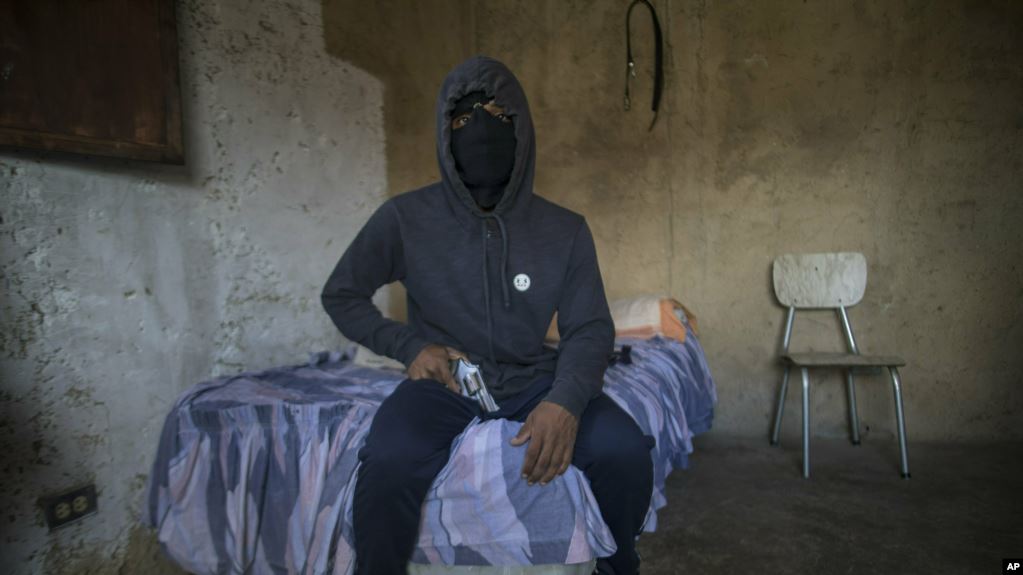 In Venezuela, Criminals Feel Effects of Economic Crisis El Negrito is a feared street criminal who sleeps with a gun under his head.
In Venezuela, Criminals Feel Effects of Economic Crisis El Negrito is a feared street criminal who sleeps with a gun under his head.
He says he cannot remember how many people he has killed. He also is quick to complain about how Venezuela’s failing economy is hurting his profits.
El Negrito, who is 24, recently spoke with reporters from the Associated Press. He did so on the condition that he would be identified only by his street name.
Even for Venezuelan criminals, he says it has become harder to earn a living. Firing a gun has become more costly. Bullets now cost $1 each. And with less money on the street, he says, robberies just do not pay like they used to.
“If you empty your clip, you’re shooting off $15,” he said.
Drop in killings, kidnapping
This week, President Nicolás Maduro’s administration reported a 39-percent drop in homicides over the last three years and a fall in kidnappings. Researchers at the Venezuelan Observatory of Violence also said murders dropped by 20 percent over the same period.
The reduction in crime has a direct link to Venezuela’s failing economy.
Inflation topped 1 million percent last year, making Venezuelan money, the bolivar, nearly useless. The severe lack of food and medicine has driven over 3.5 million people seeking better jobs to places like Colombia, Peru and Panama.
Although the country is fallen into a state of lawlessness, many Venezuelans who turn to crime find themselves in the same disorder that has led to a larger political and social meltdown.
Earlier this year, opposition leader Juan Guaidó launched a campaign to oust Maduro. The United States and more than 50 other nations have backed him. However, Maduro is still in power with military support.
Fewer attacks, more thefts
Crime in Venezuela has not exactly disappeared. It has simply changed form. Although physical attacks are down, reports of theft are rising. And, drug trafficking and illegal gold mining have become default activities for organized crime.
Venezuelans avoid looking at their cellphones while walking. Many leave gold and silver wedding rings in safe places at home. Others have grown used to checking to see whether they are being followed. When night falls, streets in the capital city of Caracas empty, as most residents follow an unofficial curfew out of fear for their safety.
“Venezuela remains one of the most violent countries in the world,” said Dorothy Kronick, who teaches political science at the University of Pennsylvania. She has carried out research in Caracas’ poorest neighborhoods. “It has wartime levels of violence — but no war.”
El Negrito leads a group of for-hire criminals called the Crazy Boys. The group is part of a complex criminal network in Petare, one of Latin America’s largest and most feared slums.
Fast kidnappings are big business. Usually, a victim is taken and held hostage for up to 48 hours while loved ones work to gather as much cash as they can find. Kidnappers focus on speed and a quick return rather than on the size of the payout.
El Negrito said the ransom they set depends on what a victim’s car costs. A deal can turn deadly if demands are not met.
El Negrito passes a silver gun between his hands as he explains how he has struggles to support his wife and young daughter. A Christian holy book is open in the room; a light wind turns its pages.
He says his group now carries out about five kidnappings a year. That is much lower than in years past. He has considered quitting and leaving the country.
'Nobody is doing well'
Robert Briceño is director of the Venezuelan Observatory of Violence. He said the decrease in homicides is a matter of basic economics: As cash becomes severely limited in Venezuela, there is less to steal.
“These days, nobody is doing well — not honest citizens who produce wealth or the criminals who prey on them,” he said.
One member of the Crazy Boys, who gave only his nickname, Dog, said he has no trouble finding bullets for his guns on the black market. He said the issue is paying for it in a country where the average person earns $6.50 a month.
“A pistol used to cost one of these bills,” he said, holding a 10 bolivar bill that can no longer be used to buy a single cigarette. “Now, this is nothing.”
I’m John Russell.
And I'm Ashley Thompson.View -
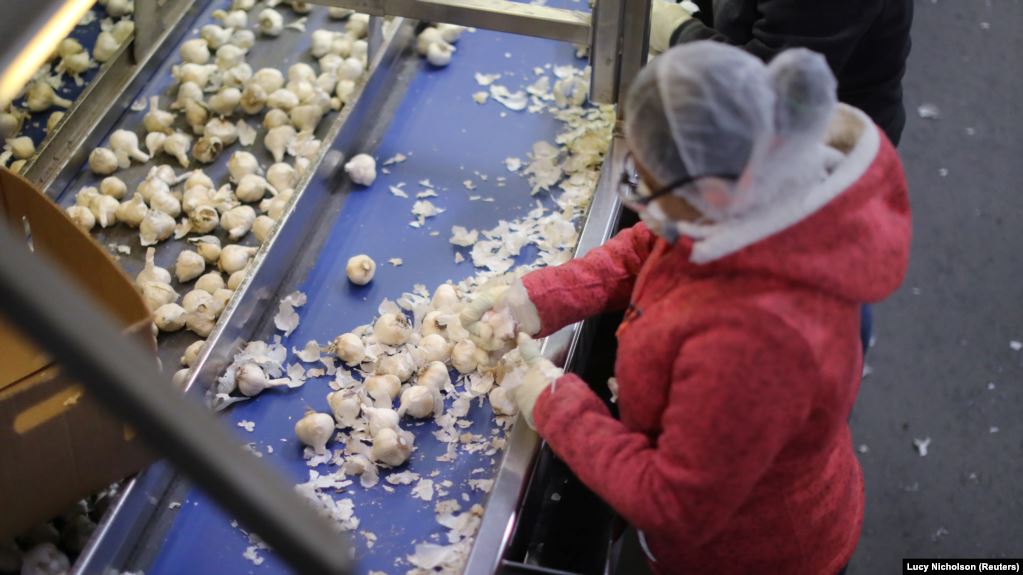 Trade War is Good for California’s Garlic Growers Millions of farmers in the United States are losing money because China is not buying the crops they grow. But garlic growers are making more money because Chinese garlic now costs almost as much as U.S.-grown garlic.
Trade War is Good for California’s Garlic Growers Millions of farmers in the United States are losing money because China is not buying the crops they grow. But garlic growers are making more money because Chinese garlic now costs almost as much as U.S.-grown garlic.
For many years, sales of garlic grown in California were going down because garlic from China was less costly. Now, California garlic sales are rising, and may go higher as the U.S. government increases tariffs on Chinese products.
Ken Christopher is executive vice president of his family’s company, Christopher Ranch. It is the largest of three commercial garlic producers in the United States. The other producers failed.
Christopher’s company wants the tariffs to remain in effect.
"In a perfect world, we'd love to see the tariffs stay on forever," he said.
U.S. garlic growers are happy because most of their sales are to Americans.
Tariffs on Chinese garlic rose from 10 to 25 percent on May 9. That is when U.S. President Donald Trump increased tariffs on $200 billion worth of Chinese products. The increase destroyed any hope that the two countries would soon agree on a trade deal.
Since then, Chinese buyers have almost completely stopped buying soybeans from the United States. U.S. soybean farmers have too much of the crop left from last year.
The Trump administration set a 10 percent tariff on imports of Chinese garlic last September. Christopher noted that, after the taxes took effect, his company’s U.S. garlic sales rose 15 percent during the last three months of 2018.
Then Trump ordered even higher tariffs this month after trade talks ended without agreement. The increase came just a few weeks before the U.S. garlic harvest.
"The timing couldn't be better for us," Christopher said. In the coming weeks, he added, he thinks there will a much larger demand for California garlic.
Christopher’s family farm stretches over 2,300 hectares of grass-like garlic fields in Gilroy, California. He had traveled to Washington D.C. last year to ask the Trump administration to include garlic in the list of imports that would face tariffs.
In the 1990s, Christopher’s grandfather urged U.S. lawmakers to enact a duty on Chinese garlic. At that time, officials accused China of dumping its garlic on the U.S. market – that is, selling the product for less than what it cost to grow.
"We understand in a broader economic sense that a trade war is not in the U.S. best interest," Ken Christopher said. "But since the tariffs were happening anyway, we needed to be sure that garlic was part of the equation."
Not everyone likes the garlic tariff. Last July, Christopher spoke in support of tariffs when he met with the U.S. International Trade Commission. At the same time, officials from one of the world’s top seasoning companies, McCormick & Company Inc., were arguing against them.
McCormick says its spice mixtures often use Chinese garlic. The company says it is a different product from the garlic grown in the United States. McCormick’s chief executive officer, Lawrence Kurzius, told the Reuters news agency that U.S. garlic cannot be used in place of Chinese garlic.
California garlic has traditionally sold at higher prices than Chinese garlic. In the wholesale market, it sells for about $60 per 30-pound box. Until recently, Chinese garlic sold for $20 per box, but that has risen to $40 with tariffs and will probably soon be higher, Kurzius said.
I’m Jill Robbins.View

